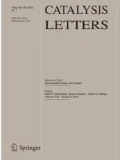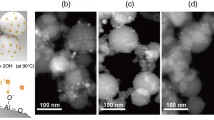Abstract
Density functional theory calculations are used to investigate thermal water decomposition over the close-packed (111), stepped (211), and open (100) facets of transition metal surfaces. A descriptor-based approach is used to determine that the (211) facet leads to the highest possible rates. A range of 96 binary alloys were screened for their potential activity and a rate control analysis was performed to assess how the overall rate could be improved.
Graphical Abstract






Similar content being viewed by others
References
Jellinek H, Kachi H (1984) The catalytic thermal decomposition of water and the production of hydrogen. Int J Hydrogen Energy 9:677–688. doi:10.1016/0360-3199(84)90265-9
Man IC, Su HY, Calle Vallejo F et al (2011) Universality in oxygen evolution electrocatalysis on oxide surfaces. ChemCatChem 3:1159–1165
Perkins C, Weimer AW (2004) Likely near-term solar-thermal water splitting technologies. Int J Hydrogen Energy 29:1587–1599. doi:10.1016/j.ijhydene.2004.02.019
Grabow LC, Studt F, Abild-Pedersen F et al (2011) Descriptor-based analysis applied to HCN synthesis from NH3 and CH4. Angew Chem 123:4697–4701. doi:10.1002/ange.201100353
Medford AJ, Shi C, Hoffmann MJ et al (2015) CatMAP: a software package for descriptor-based microkinetic mapping of catalytic trends. Catal Lett. doi:10.1007/s10562-015-1495-6
Nørskov JK, Bligaard T, Logadóttir Á et al (2002) Universality in heterogeneous catalysis. J Catal 209:275–278. doi:10.1006/jcat.2002.3615
Greeley J, Jaramillo TF, Bonde J et al (2006) Computational high-throughput screening of electrocatalytic materials for hydrogen evolution. Nat Mater 5:909–913. doi:10.1038/nmat1752
Xu Y, Lausche AC, Wang S et al (2013) In silico search for novel methane steam reforming catalysts. New J, Phys
Yoo JS, Abild-Pedersen F, Nørskov JK, Studt F (2014) A theoretical analysis of transition metal catalysts for formic acid decomposition. ACS Catal 4:1226–1233
Studt F, Sharafutdinov I, Abild-Pedersen F et al (2014) Discovery of a Ni-Ga catalyst for carbon dioxide reduction to methanol. Nat Chem. doi:10.1038/NCHEM.1873
Abild-Pedersen F, Greeley J, Studt F et al (2007) Scaling properties of adsorption energies for hydrogen-containing molecules on transition-metal surfaces. Phys Rev Lett 99:016105. doi:10.1103/PhysRevLett.99.016105
Jones G, Studt F, Abild-Pedersen F et al (2011) Scaling relationships for adsorption energies of C2 hydrocarbons on transition metal surfaces. Chem Eng Sci 66:6318–6323. doi:10.1016/j.ces.2011.02.050
Jones G, Bligaard T, Abild-Pedersen F, Nørskov JK (2008) Using scaling relations to understand trends in the catalytic activity of transition metals. J Phys 20:064239. doi:10.1088/0953-8984/20/6/064239
Logadóttir Á, Rod TH, Nørskov JK et al (2001) The Brønsted–Evans–Polanyi relation and the volcano plot for ammonia synthesis over transition metal catalysts. J Catal 197:229–231
Bligaard T, Nørskov JK, Dahl S et al (2004) The Brønsted–Evans–Polanyi relation and the volcano curve in heterogeneous catalysis. J Catal 224:206–217
Wang S, Petzold V, Tripkovic V et al (2011) Universal transition state scaling relations for (de)hydrogenation over transition metals. Phys Chem Chem Phys 13:20760–20765. doi:10.1039/c1cp20547a
Vanderbilt D (1990) Soft self-consistent pseudopotentials in a generalized eigenvalue formalism. Phys Rev B 41:7892–7895. doi:10.1103/PhysRevB.41.7892
Giannozzi P, Baroni S, Bonini N et al (2009) QUANTUM ESPRESSO: a modular and open-source software project for quantum simulations of materials. J Phys: Condens Matter 21:395502. doi:10.1088/0953-8984/21/39/395502
Wellendorff J, Lundgaard KT, Møgelhøj A et al (2012) Density functionals for surface science: exchange-correlation model development with Bayesian error estimation. Phys Rev B 85:235149. doi:10.1103/PhysRevB.85.235149
Monkhorst HJ, Pack JD (1976) Special points for Brillouin-zone integrations. Phys Rev B 13:5188–5192. doi:10.1103/PhysRevB.13.5188
Falsig H, Shen J, Khan TS et al (2013) On the structure sensitivity of direct NO decomposition over low-index transition metal facets. Top Catal 57:80–88. doi:10.1007/s11244-013-0164-5
Medford AJ, Lausche AC, Abild-Pedersen F et al (2013) Activity and selectivity trends in synthesis gas conversion to higher alcohols. Top Catal. doi:10.1007/s11244-013-0169-0
Henkelman G, Uberuaga BP, Jónsson H (2000) A climbing image nudged elastic band method for finding saddle points and minimum energy paths. J Chem Phys 113:9901–9904. doi:10.1063/1.1329672
Nørskov JK, Studt F, Abild-Pedersen F, Bligaard T (2014) Fundamental concepts in heterogeneous. Catalysis. doi:10.1002/9781118892114
Yoo JS, Khan TS, Abild-Pedersen F et al (2015) On the role of the surface oxygen species during A-H (A = C, N, O) bond activation: a density functional theory study. Chem Commun 51:2621–2624. doi:10.1039/C4CC08658A
Wang S, Temel B, Shen J et al (2010) Universal Brønsted-Evans-Polanyi relations for C-C, C–O, C–N, N–O, N–N, and O–O dissociation reactions. Catal Lett 141:370–373. doi:10.1007/s10562-010-0477-y
Yoo JS, Zhao Z-J, Nørskov JK, Studt F (2015) Effect of Boron modifications of palladium catalysts for the production of hydrogen from formic acid. ACS Catal. doi:10.1021/acscatal.5b01497
Bligaard T, Nørskov JK (2007) Ligand effects in heterogeneous catalysis and electrochemistry. Electrochim Acta 52:5512–5516. doi:10.1016/j.electacta.2007.02.041
Greeley J, Mavrikakis M (2004) Alloy catalysts designed from first principles. Nat Mater 3:810–815. doi:10.1038/nmat1223
Greeley J, Stephens I, Bondarenko AS et al (2009) Alloys of platinum and early transition metals as oxygen reduction electrocatalysts. Nat Chem 1:552–556
Stegelmann C, Andreasen A, Campbell CT (2009) Degree of rate control: how much the energies of intermediates and transition states control rates. J Am Chem Soc 131:8077–8082. doi:10.1021/ja9000097
Acknowledgments
The authors thank the US Department of Energy, Office of Basic Energy Sciences.
Author contributions
This Project was carried out as part of the course “Electronic Structure Theory and Applications to Chemical Kinetics” (CHEMENG 444/ENERGY 256) from the Department of Chemical Engineering and the Department of Energy Resources Engineering at Stanford University. CT, KL, JW, and JKN designed the project. CT, KL, JSY, HA, LDC, CD, TG, CG, TJ, CK, AL, XL, BL, RM, JHM, LP, AS, JW, MW, MY, ZJZ carried out the calculations and performed the analysis.
Author information
Authors and Affiliations
Corresponding author
Additional information
Hassan Aljama, Leanne D. Chen, Colin F. Dickens, Taylor S. Geisler, Chris J. Guido, Thomas M. Joseph, Charlotte S. Kirk, Allegra A. Latimer, Brandon Loong, Ryan J. McCarty, Joseph H. Montoya, Lasana Power, Aayush R. Singh, Joshua J. Willis, Martin M. Winterkorn, and Mengyao Yuan have contributed equally to this work.
Electronic supplementary material
Below is the link to the electronic supplementary material.
Rights and permissions
About this article
Cite this article
Tsai, C., Lee, K., Yoo, J.S. et al. Direct Water Decomposition on Transition Metal Surfaces: Structural Dependence and Catalytic Screening. Catal Lett 146, 718–724 (2016). https://doi.org/10.1007/s10562-016-1708-7
Received:
Accepted:
Published:
Issue Date:
DOI: https://doi.org/10.1007/s10562-016-1708-7




